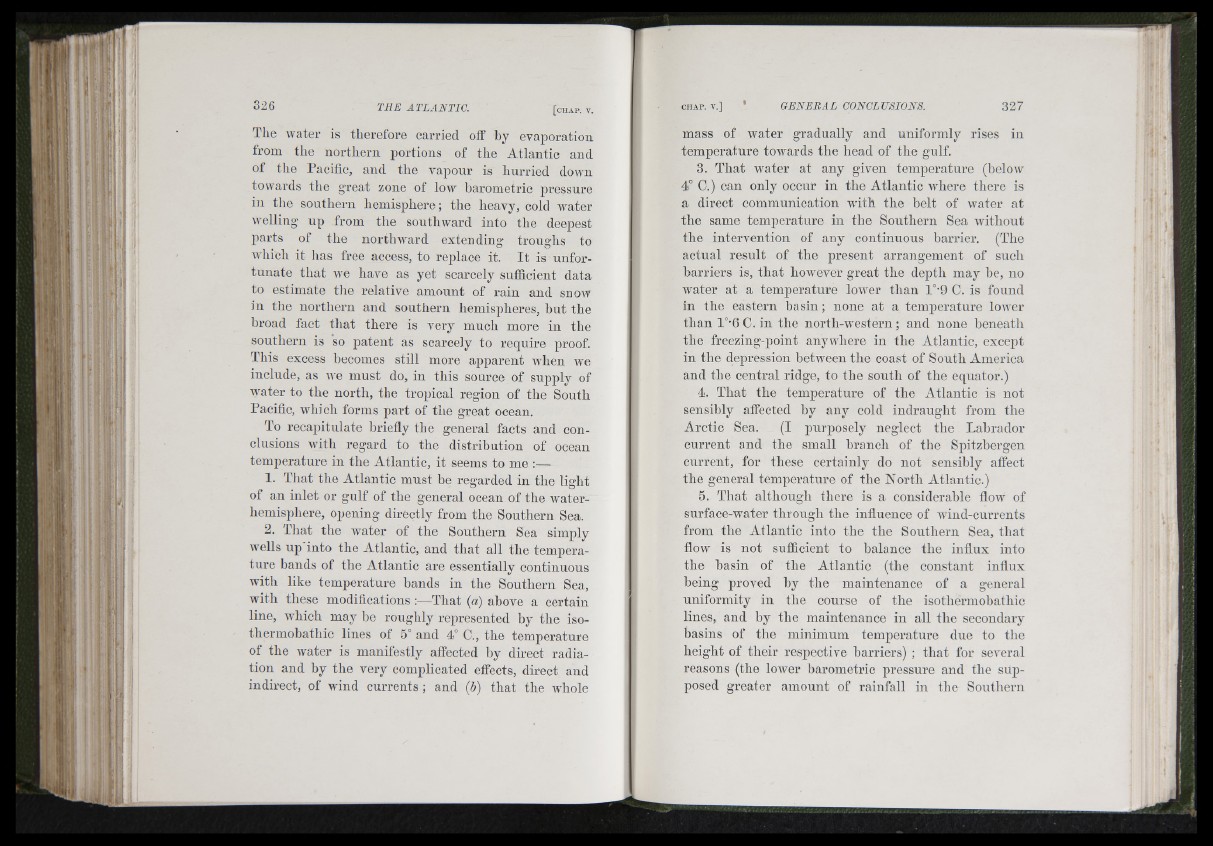
..M [ill'
ri
MÌ nl ! '
r ii <
’ •!! i'
iV
I vj!,
lli:
lDrVi I
i
Ii i'
it..l
r '.1 r
. [
'
ri ! I
Tlie water is therefore carried off hy evajioration
from the northern portions of the Atlantic and
of the Pacific, and the vapour is hurried down
towards the great zone of low barometric pressure
in the southern hemisphere ; the heavy, cold water
welling up from the southward into the deepest
parts of the northward extending troughs to
Avliicli it lias free access, to replace it. It is unfortunate
that we have as yet scarcely sufficient data
to estimate tlie relative amount of rain and snow
in the northern and southern hemispheres, but tbe
broad fact tbat there is very much more in the
southern is so patent as scarcely to require proof.
Tbis excess becomes still more apparent when we
include, as u e must do, in tbis source of supply of
water to tbe north, the trojiical region of tbe South
Pacific, which forms part of the great ocean.
To recapitulate briefly the general facts and conclusions
Avitb regard to the distribution of ocean
temperature in the Atlantic, it seems to me :—
1. Tbat tbe Atlantic must be regarded in tbe liMit
of an inlet or gulf of tbe general ocean of the water-
hemisphere, opening directly from the Southern Sea.
2. riiat tbe water of the Southern Sea simply
wells up into the Atlantic, and tbat all tbe temperature
bands of the Atlantic are essentially continuous
witb like temperature bands in the Southern Sea,
witb these modifications :—That (a) above a certain
line, which may be roughly represented by tbe iso-
thermobatbic lines of 5° and 4° C., tbe temperature
of tbe water is manifestly affected by direct radiation
and by the very complicated effects, direct and
indirect, of wind currents; and (b) that the Avhole
mass of water gradually and uniformly rises in
temperature towards the bead of tbe gulf.
3. Tbat water at any given temperature (below
4° 0.) can only occur in tbe Atlantic where there is
a direct communication with tbe belt of water at
the same temperature in the Southern Sea without
the intervention of any continuous barrier. (The
actual result of tbe present arrangement of sucb
barriers is, that however great the depth may be, no
water at a temperature loAver than l°-9 G. is found
in the eastern basin ; none at a temperature loAA’er
tban 1°'6 C. in the nortb-western ; and none beneath
the freezing-point anywhere in the Atlantic, except
in the depression between tbe coast of South America
and tbe central ridge, to the soutb of the equator.)
4. That the temperature of the Atlantic is not
sensibly affected by any cold indraught from tbe
Arctic Sea. (I purposely neglect tbe Labrador
current and the small branch of tbe Spitzbergen
current, for tbese certainly do not sensibly affect
the general temperature of tbe North Atlantic.)
5. That althongh there is a considerable flow of
surface-water through the influence of Avind-currents
from the Atlantic into the the Southern Sea, that
flow is not sufiicient to balance the influx into
the basin of the Atlantic (the constant influx
heing proved hy the maintenance of a general
uniformity in the course of the isothermobathic
lines, and by the maintenance in all the secondary
basins of tbe minimum temperature due to tbe
beigbt of tbeir respective barriers) ; tbat for several
reasons (tbe lower barometric pressure and tbe supposed
greater amount of rainfall in tlie Sontbern
■jL * l , i